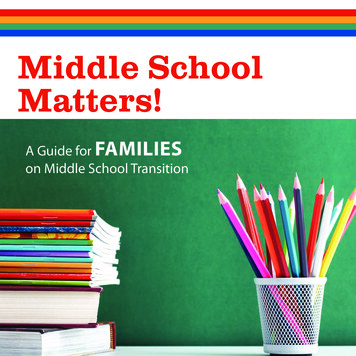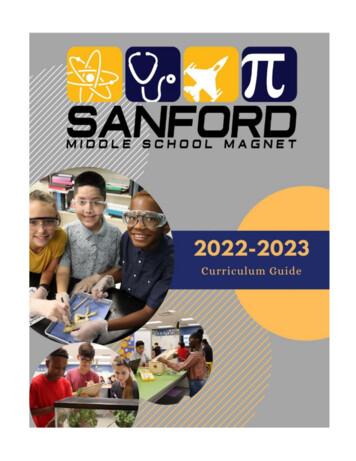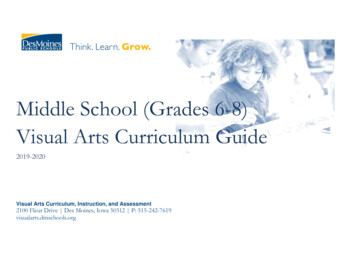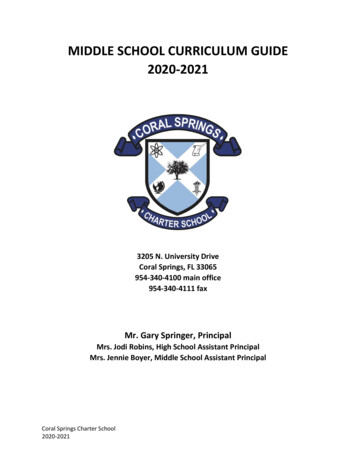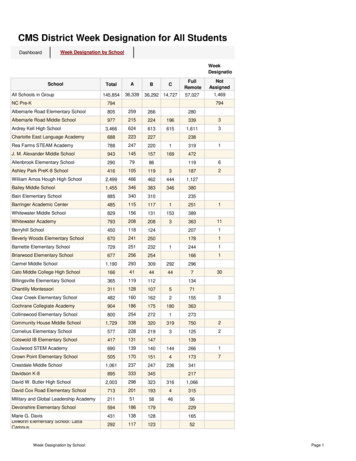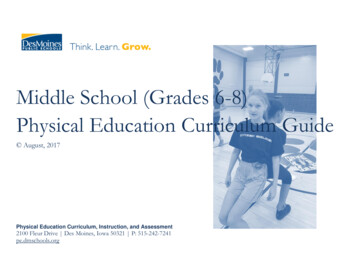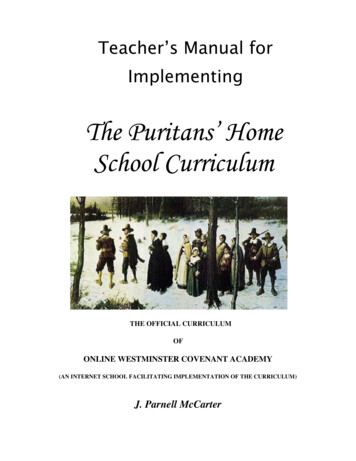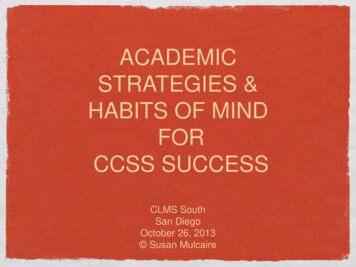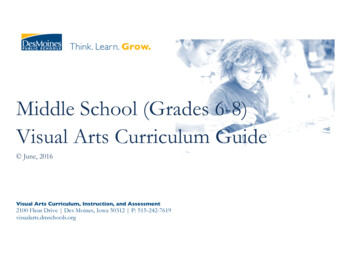
Transcription
Middle School (Grades 6-8)Visual Arts Curriculum Guide June, 2016Visual Arts Curriculum, Instruction, and Assessment2100 Fleur Drive Des Moines, Iowa 50312 P: 515-242-7619visualarts.dmschools.org
Middle School Visual Arts Curriculum GuideSuperintendentThomas Ahart, Ed.DExecutive Director of Secondary Teaching & LearningNoelle TichyVisual Arts Curriculum CoordinatorSarah DoughertySecondary Curriculum Lead Team Editors – Middle SchoolDerrick Ogden, Brody Middle SchoolDawn Pinion, Weeks Middle SchoolVirginia Rogers, Hiatt Middle SchoolDiana Givens, McCombs Middle SchoolSecondary Curriculum Lead Team Editors – High SchoolBryan Butcher, North High SchoolSam Chiodo, Roosevelt High SchoolMichel Gude, Scavo Alternative High SchoolSamantha Jones-Tweedy, Future Pathways/ GatewayJason Soliday, East High SchoolHeather Worthington, Lincoln High SchoolJanet Murillo, Hoover High School1
Middle School Visual Arts Curriculum GuideForeword The curriculum in this document is based on theNational Core Arts Standards published in the spring of 2014. Ithas been developed by visual art educators and curriculumspecialists in the Des Moines Public Schools. The objectives inthis curriculum guide are the minimum requirements in the visualarts that set rigorous, relevant, clear, and measurable learningtargets and expectations for what teachers should teach andstudents should learn. Schools and educators are continuouslyencouraged to go beyond these targets to better serve the needsof all students in the visual arts.Definition of the Visual ArtsVisual arts include the traditional fine arts such as drawing,painting, printmaking, photography, and sculpture; media artsincluding film, graphic communications, animation, and emergingtechnologies; architectural, environmental, and industrial artssuch as urban, interior, product, and landscape design; folk arts;and works of art such as ceramics, fibers, jewelry, works in wood,paper, and other materials. –National Art Education Association2
Middle School Visual Arts Curriculum GuideTable of ContentsHow to use this document .4DMPS Philosophy and Objectives 5-6Document Structures .7Reporting Clusters .8-13Design Concepts .8Studio Skills .9Critical Analysis .10Making Connections .12Grade Level Scopes .14-16Sixth Grade .14Seventh Grade .15Eighth Grade . .16Assessment Rubric .17Common Vocabulary .18Elements of Art . 19Principles of Design . .20Four-Step Critical Analysis Process . .213
Middle School Visual Arts Curriculum GuideHow to use this document:This curriculum guide is not A lock-step instructional guide detailing exactly when and how you teach.Meant to restrict your creativity as a teacher.A ceiling of what your students can learn, nor a set of unattainable goals.Instead, the curriculum guide is meant to be a common vision for student learning and a set ofstandards by which to measure and report student progress and provide meaningful feedback.The curriculum guide outlines which learning goals are most essential for student learning; it is our district’s guaranteed and viablecurriculum. The expectation is that every student in our district, regardless of school or classroom, will know and understand theselearning goals. As the classroom teacher, you should use the curriculum guide to help you to decide how to scaffold up to thelearning goals, and extend your students’ learning beyond them.The curriculum guide is a planning tool; assessed clusters and topics are provided, but as the instructional leader of yourclassroom, you determine the scope and sequence in which you will introduce the prioritized learning goals. You areencouraged to create your own sub-units of study within each cluster using the topics as a starting point. Within this document youwill find a foundational structure for planning instruction in the visual arts which can be supplemented with unlimited materials fromany number of sources, including but not limited to district texts and prints.Please consider this guide a living and dynamic document, subject to change and a part of a continuous feedback loop. As part ofthis logic model, common task banks and district-wide common formative assessments are being generated during the 2014-2015and 2015-2016 school years.4
Middle School Visual Arts Curriculum GuideDes Moines Public Schools Educational PhilosophyVisionBecoming the model for urban education in the United States.Mission StatementThe Des Moines Public Schools Exist So That Graduates Possess the Knowledge, Skills and Abilities to Be Successful at the Next Stage of Their Lives.Student ExpectationsStudents demonstrate proficiency and understanding of a rigorous core curriculum: They demonstrate proficiency in reading, writing, speaking and listeningThey demonstrate proficiency in mathematics, including algebra and geometryThey demonstrate financial and economic literacyThey demonstrate an understanding of the value of fine and performing arts in societyThey demonstrate proficiency in technological and information literacyThey demonstrate proficiency in science, including life, earth and physical scienceStudents possess the knowledge and skills to be self-directed and autonomous: TheyTheyTheyTheydemonstrate critical thinking and problem solving skillsexercise sound reasoning in making complex choicesexhibit creative, innovative and entrepreneurial thinkingunderstand the attributes of physical and mental well-beingStudents have world awareness: TheyTheyTheyTheylearn from and work with individuals representing diverse cultures and religions in a spirit of mutual respect in school, work and communityunderstand the rights and obligations of citizenship at local, state, national, and global levelsare actively engaged in community lifewill be exposed to languages and cultures of the world5
Middle School Visual Arts Curriculum Guide Des Moines Public Schools K-12 Student Learning Objectives in the Visual Artso Students can communicate at a foundational level in the visual arts. This includes knowledge and skills in the use of basic vocabularies,materials, tools, techniques, and intellectual methods of the discipline.o Students can communicate proficiently in at least one art form, including the ability to define and solve artistic problems with insight,reason, and technical proficiency.o Students can develop foundational evaluations and analyses of works of art from structural, historical, and cultural perspectives.o Students can develop an informed acquaintance with exemplary works of art from a variety of cultures and historical periods, and a basicunderstanding of historical development in the arts disciplines, across the arts as a whole, and within cultures. Effective Components of an Educational Studio Programo Demonstrations of artistic techniques and uses of mediao Opportunities for practice, experimentation, and refinement based on effective feedbacko Support for divergent thinking and multiple learning outcomeso A rich and robust variety of visual referenceso A variety of critique and response formatso Introductions to and expectations for use of appropriate art vocabularyo Connections among artists, careers, and art in everyday life and communitieso An organizational system for storage and disbursement of materials and toolso Clear and maintained expectations for art room safety, cleaning, and classroom procedureso Integrations and connections with other content areaso Displays of various student works within the school and the community Learning Clusters for Grades 6-8o Design Concepts: Elements of Art and Principles of Designo Studio Skills: Media and Processeso Critical Analysis: Planning and Evaluatingo Making Connections: Connecting to Contexts6
Middle School Visual Arts Curriculum GuideDocument StructuresLearning goals for all curricular areas are organized by overarching concepts called topics. Within those topics live a learning goal. All learning goals for thevisual arts are guided by the 2014 National Visual Arts Standards and assessed on the provided reporting scales. The outline below serves to define thevarious elements of the curriculum structure. Learning Topic – The Overarching ConceptooDefinition of the topic.National Standards alignments – those most closely related to the overarching concept.§ Anchor Standard: Anchor standards define the expectations for students entering college and careers, and provide the foundation for the K-12 visual arts standards.§ Enduring Understanding: Statements summarizing important ideas and core processes that are central to visual arts and have lasting value beyond the classroom. Theysynthesize what students should understand—not just know or do—as a result of studying visual arts.§ Essential Questions: Organizing questions to set the focus for lessons or units. They are the initiators of creative and critical thinking.Evidence of student learning is assessed on a four-point scale, common throughout the district. Scales are designed to measure each learning topic. Thegeneralized scale, with student-friendly language included, is below.SCALESCORE43210/MACADEMIC DESCRIPTORSTUDENT-FRIENDLY DESCRIPTORExceeding StandardI have demonstrated deep understandingthat goes beyond the learning goalMeeting StandardI have met the learning goalDeveloping Toward StandardI have the foundational skills and knowledgefor the learning goal and I am almost thereThe evidence I have submitted shows I have along way to go to reach the learning goalInsufficient ProgressNo evidence of student understanding in submitted work ORMissing – student has not submitted evidenceI have not submitted evidence of learning for the learning goal*For more information on district assessment and grading practices, please refer to the Grading Practices website l7
Middle School Visual Arts Curriculum Guide Reporting Cluster -- Design Concepts: Elements of Art and Principles of Designo The Elements of Art are defined as the visual components of color, form, line, shape, space, texture, and value.o National Standards alignments§ Anchor Standard: Organize and develop artistic ideas and work.§ Enduring Understanding: People create and interact with objects, places, and design that define, shape, enhance, and empower their lives.§ Essential Questions: How do artists and designers create works of art or design that effectively communicate?§ Grade-level student learning objectives/ task generators 6th Grade – Design or redesign objects, places, or systems that meet the identified needs of diverse users. 7th Grade – Apply visual organization strategies to design and produce a work of art that clearly communicatesinformation or ideas. 8th Grade – Select, organize, and design images and words to make visually clear and compelling presentations Assessment Scale1Student’s performance reflectsinsufficient progress towardsfoundational skills andknowledge.2Students will recognize orrecall specific vocabularyincluding, but not limited to: Line, shape, forms, space, color, texture,balance, emphasis, movement, pattern,repetition, proportion, rhythm, variety,unity, composition, perspective,craftsmanship, portfolio, rubric, 2D/3D,technique, context, mediaStudents demonstrate theyhave developed the ability to: Identify and describe theElements of Art and thePrinciples of Design.3Students demonstrate they havethe ability to: Independently applymultiple Elements of Artto an original artwork. Independently applymultiple Principles ofDesign to an originalartwork. Provide evidence for theirartistic choices.4In addition to score 3.0performance, studentsdemonstrate in-depthinferences and applicationsthat go beyond the learningtarget.8
Middle School Visual Arts Curriculum Guide Reporting Cluster – Studio Skills: Media and Processesoo Artistic Media and Processes are defined as the means of expression (tools, materials, and techniques) used to produce a work of art.New National Standards alignments§ Anchor Standard: Organize and develop artistic ideas and work.§ Enduring Understandings Artists and designers experiment with forms, structures, materials, concepts, media, and art-making approaches. Artists and designers balance experimentation and safety, freedom and responsibility, while developing and creating art§ Essential Questions How do artists work? How do artists care for and maintain materials, tools, and equipment? What responsibilities come with the freedom to create?§ Grade-level student learning objectives/ task generators 6th Gradeo Demonstrate openness in trying new ideas, materials, methods, and approaches in making art.o Demonstrate quality craftsmanship through care for and use of materials, tools, and equipment.th 7 Grade -- Demonstrate persistence in developing skills with various materials and methods in making art. 8th Grade – Demonstrate willingness to experiment, innovate, and take risks to pursue ideas in art makingAssessment Scale1Student’s performance reflectsinsufficient progress towardsfoundational skills andknowledge.2Students will recognize or recallspecific vocabulary including, but notlimited to: Craftsmanship, portfolio, technique,mediaStudents demonstrate they havedeveloped the ability to: Identify and describe theintended uses of media andtools. Identify and describe artisticprocesses and techniques.3Students demonstrate theyhave the ability to: Apply intended uses ofmedia and tools in anartistic process ortechnique to create anoriginal artwork. Provide evidence for theirartistic choices.4In addition to score 3.0performance, studentsdemonstrate in-depthinferences and applicationsthat go beyond the learningtarget.9
Middle School Visual Arts Curriculum Guide Reporting Cluster – Critical Analysis: Planning and EvaluatingoooPlanning is defined as the process of conceiving and developing new artistic ideas and work.Evaluating is defined as judging the merits or value of a piece of art based on a set of criteria.New National Standards alignments§Anchor Standard: Generate and conceptualize artistic ideas and work. Refine and complete artistic work. Apply criteria to evaluate artistic work.§Enduring Understandings Creativity and innovative thinking are essential life skills that can be developed. Artists and designers shape artistic investigations, following or breaking with traditions, in pursuit of creative goals. Artists and designers develop excellence through practice and constructive critique, reflecting on, revising, and refining work over time. People gain insights into meanings of artworks by engaging in the process of art criticism. People evaluate art based on various criteria.§Essential Questions What conditions, attitudes, and behaviors support creativity and innovative thinking? What factors prevent or encourage people to take creative risks? How does collaboration expand the creative process? How does collaboratively reflecting on work help us experience it more fully and develop it more completely? How does the viewer “read” a work of art? How is personal preference different from an evaluation?§Grade-level student learning objectives/ task generators 6th Gradeo Collaboratively combine concepts to generate an innovative idea for art making.o Formulate an artistic investigation of personally relevant content for creating art.o Reflect on whether one’s artwork conveys the intended meaning and revise accordingly.o Interpret art by analyzing subject matter and characteristics of structure to identify moods orideas.o Develop and apply relevant criteria to evaluate a work of art. 7th Gradeo Apply methods to overcome creative blocks.o Develop criteria to guide making a work of art or design to meet an identified goal.o Reflect on and explain important information about personal artwork in an artist statement.o Interpret art by analyzing art-making approaches, subject matter, and characteristics ofstructure to identify moods or ideas.o Compare and explain evaluation based on personal criteria versus an established set ofcriteria.th 8 Gradeo Document early stages of the creative process visually and/or verbally in traditional or newmedia.o Collaboratively shape an artistic investigation of an aspect of contemporary life using acontemporary practice of art or designo Apply relevant criteria to examine, reflect on, and plan revisions for a work of art or design inprogress.o Interpret are by analyzing the how the interaction of art-making approaches, subject matter,and characteristics of structure contributes to understanding moods or ideas.o Create a convincing and logical argument to support an evaluation of a work of art.10
Middle School Visual Arts Curriculum Guide Assessment Scale (Planning and Evaluating)123Student’s performance reflects Students will recognize or recall Students demonstrate they haveinsufficient progress towardsspecific vocabulary including,the ability to:foundational skills andbut not limited to: Formulate, communicate,knowledge. Composition, perspective, mediaand implement an actionStudents demonstrate they haveplan, making appropriatedeveloped the ability to:adjustments. Formulate and Critically analyze andcommunicate and actionevaluate their own work orplan.the work of others basedon established criteria. Formulate and convey aresponse to their own Collaborate with peers orartwork and the work ofother learning partners.others.4In addition to score 3.0performance, studentsdemonstrate in-depthinferences and applicationsthat go beyond the learningtarget.11
Middle School Visual Arts Curriculum Guide Reporting Cluster – Making Connections: Connecting to ContextsooConnecting to Contexts is defined as exploring links between works of art and history, society, culture, and personal experiences.New National Standards alignments§ Anchor Standard Perceive and analyze artistic work. Relate artistic ideas and works with societal, cultural, and historical context to deepen understanding. Synthesize and relate knowledge and personal experiences to make art.§ Enduring Understandings Engagement with art can lead to understanding and appreciation of self, others, the natural world, and constructed environments. People develop ideas and understandings of society, culture, and history through their interactions with and analyses of art.§ Essential Questions How do life experiences influence the way you relate to art? How does art help us understand the lives of people of different times, places, and cultures? How is art used to impact the views of society?§ Grade-level student learning objectives/ task generators 6th Gradeo Identify and interpret works of art or design that reveal ways people live around the world and what they value.o Analyze how art reflects changing times, traditions, resources, and cultural issues.o Generate a collection of ideas reflecting current interests and concerns that could be investigated in art making. 7th Gradeo Analyze how response to art is influenced by understanding the time and place which it was created.o Create visual documentation of places and times in which people gather to make or experience art. 8th Gradeo Explain how an individual’s aesthetic choices are influenced by culture and environment.o Distinguish different ways art is used to represent, establish, reinforce, and reflect group identity.o Collaboratively make art to reflect on and reinforce positive aspects of group identity.12
Middle School Visual Arts Curriculum Guide Assessment Scale (Connecting to Contexts)123Student’s performance reflects Students will recognize or recall Students demonstrate they haveinsufficient progress towardsspecific vocabulary such as:the ability to:foundational skills and Context Apply contextual elementsknowledge.Students demonstrate they havefrom history, cultures,developed the ability to:artistic movements, andsociety to their own Identify contextualartwork.elements from history,cultures, artisticmovements, and society inthe work of others.4In addition to score 3.0performance, studentsdemonstrate in-depthinferences and applicationsthat go beyond the learningtarget.13
Middle School Visual Arts Curriculum GuideGrade Level Scope – Sixth GradeUse these National Standards aligned student objectives to design instruction and generate tasks with the aim of meeting the learning targetsoutlined on the district assessment scales. Design Concepts: Elements of Art and Principles of Designo Design or redesign objects, places, or systems that meet the identified need of diverse users.Studio Skills: Media and Processeso Demonstrate openness in trying new ideas, materials, methods, and approaches in making art.o Demonstrate quality craftsmanship through care for and use of materials, tools, and equipment.Critical Analysis: Planning and Evaluatingo Collaboratively combine concepts to generate an innovative idea for art making.o Formulate an artistic investigation of personally relevant content for creating art.o Reflect on whether one’s artwork conveys the intended meaning and revise accordingly.o Interpret art by analyzing subject matter and characteristics of structure to identify moods or ideas.o Develop and apply relevant criteria to evaluate a work of art.Making Connections: Connecting to Contextso Identify and interpret works of art or design that reveal ways people live around the world and what they value.o Analyze how art reflects changing times, traditions, resources, and cultural issues.o Generate a collection of ideas reflecting current interests or concerns that could be investigated in art making.14
Middle School Visual Arts Curriculum GuideGrade Level Scope – Seventh GradeUse these National Standards aligned student objectives to design instruction and generate tasks with the aim of giving students multipleopportunities to meet the learning targets outlined on the district assessment scales. Design Concepts: Elements of Art and Principles of Designo Apply visual organization strategies to design and produce a work of art that clearly communicates information or ideas.Studio Skills: Media and Processeso Demonstrate persistence in developing skills with various materials and methods in making art.Critical Analysis: Planning and Evaluatingo Apply methods to overcome creative blocks.o Develop criteria to guide making a work of art or design to meet an identified goal.o Reflect on and explain important information about personal artwork in an artist statement.o Interpret art by analyzing art making approaches, subject matter, and characteristics of structure to identify moods or ideas.o Compare and explain evaluation based on personal criteria versus an established set of criteria.Making Connections: Connecting to Contextso Analyze how response to art is influenced by understanding the time and place which it was created.o Create visual documentation of places and times in which people gather to make or experience art.15
Middle School Visual Arts Curriculum GuideGrade Level Scope – Eighth GradeUse these National Standards aligned student objectives to design instruction and generate tasks with the aim of meeting the learning targetsoutlined on the district assessment scales. Design Concepts: Elements of Art and Principles of Designo Select, organize, and design images and words to make visually clear and compelling presentations.Studio Skills: Media and Processeso Demonstrate willingness to experiment, innovate, and take risks to pursue ideas in art making.Critical Analysis: Planning and Evaluatingo Document early stages of the creative process visually and/or verbally in traditional or new media.o Collaboratively shape an artistic investigation of an aspect of contemporary life using a contemporary practice of art or design.o Apply relevant criteria to examine, reflect on, and plan revisions for a work of art or design in progress.o Interpret are by analyzing the how the interaction of art-making approaches, subject matter, and characteristics of structure contributes tounderstanding moods or ideas.o Create a convincing and logical argument to support an evaluation of a work of art.Making Connections: Connecting to Contextso Explain how an individual’s aesthetic choices are influenced by culture and environment.o Distinguish different ways art is used to represent, establish, reinforce, and reflect group identity.o Collaboratively make art to reflect on and reinforce positive aspects of group identity.16
Middle School Visual Arts Curriculum GuideCluster: Topic1InsufficientProgressDesign Concepts:Elements of Artand Principles ofDesignStudent’s performancereflects insufficientprogress towardsfoundational skills andknowledge.Students will recognize or recall specific vocabularyincluding, but not limited to: Line, shape, forms, space, color, texture, balance, emphasis,movement, pattern, repetition, proportion, rhythm, variety,unity, composition, perspective, craftsmanship, portfolio,rubric, 2D/3D, technique, context, mediaStudents demonstrate they have developed the ability to: Identify and describe the Elements of Art and thePrinciples of Design.Students demonstrate they have the ability to: Independently apply multiple Elements ofArt to an original artwork. Independently apply multiple Principles ofDesign to an original artwork. Provide evidence for their artistic choices.In addition to score 3.0performance, studentsdemonstrate in-depthinferences andapplications that gobeyond the learningtarget.Studio Skills:Media andProcessesStudent’s performancereflects insufficientprogress towardsfoundational skills andknowledge.Students demonstrate they have the ability to: Apply intended uses of media and tools toan artistic process or technique to create anoriginal artwork. Provide evidence for their artistic choices.In addition to score 3.0performance, studentsdemonstrate in-depthinferences andapplications that gobeyond the learningtarget.Critical Analysis:Planning andEvaluatingStudent’s performancereflects insufficientprogress towardsfoundational skills andknowledge.Students will recognize or recall specific vocabularyincluding, but not limited to: Craftsmanship, portfolio, technique, mediaStudents demonstrate they have developed the ability to: Identify and describe the intended uses of mediaand tools. Identify and describe artistic processes andtechniques.Students will recognize or recall specific vocabularyincluding, but not limited to: Composition, perspective, mediaStudents demonstrate they have developed the ability to: Formulate and communicate and action plan. Formulate and convey a response to their ownartwork and the work of others.Students demonstrate they have the ability to: Formulate, communicate, and implementan action plan, making appropriateadjustments. Critically analyze and evaluate their ownwork or the work of others based onestablished criteria. Collaborate with peers or other learningpartners.In addition to score 3.0performance, studentsdemonstrate in-depthinferences andapplications that gobeyond the learningtarget.MakingConnections:Connecting toContextsStudent’s performancereflects insufficientprogress towardsfoundational skills andknowledge.Students will recognize or recall specific vocabularyincluding, but not limited to: ContextStudents demonstrate they have developed the ability to: Identify contextual elements from history, cultures,artistic movements, and society in the work ofothers.Students demonstrate they have the ability to: Apply contextual elements from history,cultures, artistic movements, and society totheir own artwork.In addition to score 3.0performance, studentsdemonstrate in-depthinferences andapplications that gobeyond the learningtarget.23Developing Toward StandardMeeting Standard4ExceedingStandard17
Middle School Visual Arts Curriculum GuideCommon Vocabulary TermsCommon vocabulary for selected media, styles, art movements, and art expressions reflect the concepts, techniques, and skills foreach grade level and course of study. Students will use these terms in oral, written, and visual communications. Teachers areencouraged to provide additional visual arts vocabulary to the identified lists.Required Terms LineShapeFormsSpaceColorTexture RhythmVarietyUnity Recommended echniqueContextMediaCritique dthDepthNegative SpacePositive Space tarySurfaceScaleSymmetryAsymmetry ContrastFocal PointSymbolMoodHarmony18
Middle School Visual Arts Curriculum Guide19
Middle School Visual Arts Curriculum Guide20
Middle School Visual Arts Curriculum GuideFour-Step Critical Analysis Process Step 1: Describe – What do you see?o Credit line information such as title, artist, date created, size, medium, location, genre.o What do you see in the art work? Use objective observations and identification skills. Alldescriptions must be observable facts.o EXAMPLE: “Starry Night, Vincent Van Gogh, 1832 I see a large cypress tree in the foreground. Ican tell it is a cypress by the shape. The majority of the picture is taken up by a night sky. There aremany stars in the sky. Etc .” Step 2: Analyze—How is the work organized?o Focus on how the Elements of Art and Principles of Design have been used in the artwork. You arestill collecting
Middle School Visual Arts Curriculum Guide 4 How to use this document: This curriculum guide is not A lock-step instructional guide detailing exactly when and how you teach. Meant to restrict your creativity as a teacher. A ceiling of what your students can learn, nor a set of unattainable goals. Instead, the curriculum gu
